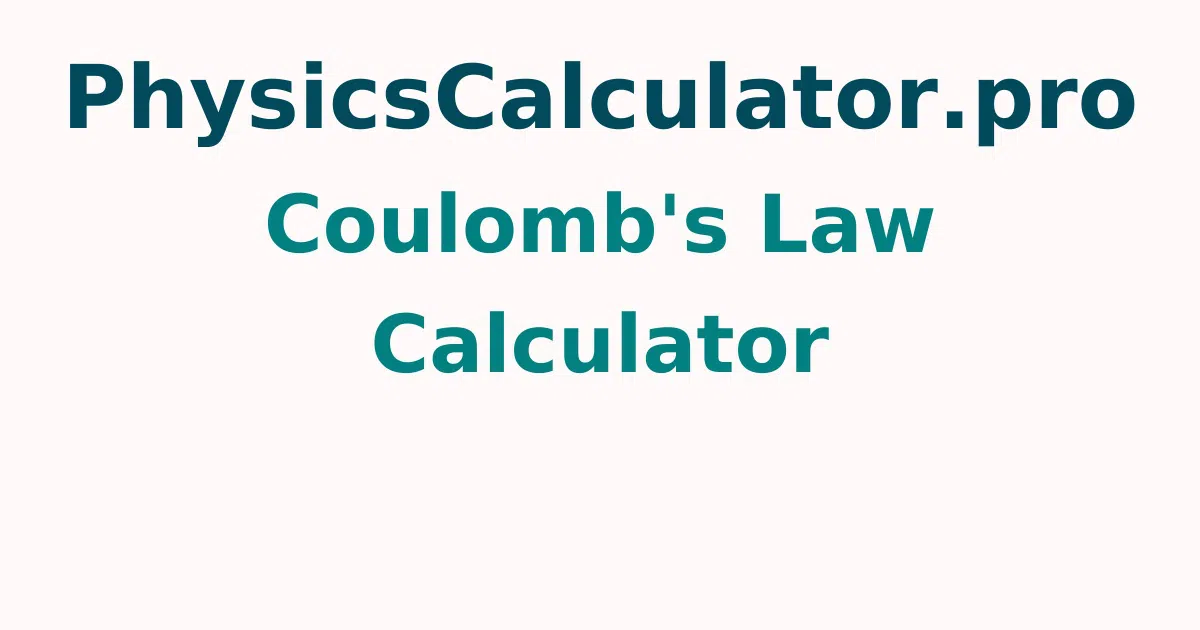Coulomb's Law Calculator
The Coulomb's Law Calculator is a useful tool for calculating the attractive or repulsive force between two charged particles that are stationary. To obtain electric force quickly, simply enter the corresponding charges q1, q2, and the distance between them, then click the calculate button.
What is Coulomb’s Law?
Coulomb's law states that the attraction or repulsion force between two charged bodies is proportional to the product of their charges and inversely proportional to the square of their distance. It operates on the line that connects the two point charges. Coulomb's law, sometimes known as Coulomb's inverse-square law, is a physical law that measures the amount of force between two stationary, electrically charged materials or particles.
The formula of Coulomb’s law is given as F = K[q1q2/d2]
- Here,
- q1 = Charge of the first body
- q2 = Charge of the second body
- d = Distance between the two bodies
- K = Electrostatic constant (approximately equal to 9 × 10^9)
How to use Coulomb's law to determine electrostatic force?
If you know the distance between two objects, you can readily calculate the electrostatic force between them. The product of Coulomb's constant ‘q1’, and the other charge ‘q2’, divided by the square of the distance between them yields force F. i.e. F = keq₁q₂/r²
We can calculate the distance between objects by rearranging Coulomb's Law, i.e. r = √ (ke × q₁ × q₂ / F)
If you know the electrostatic charge of one object, its force, and the distance between them, you may use the formula q₂ = (Fr²)/(ke x q₁)to compute the other charge.
Example 1:
Two balloons are charged in the same way, with the same amount and type of charge: -0.0025 C. They are kept at an 8-meter separating distance. Calculate the amount of the electrical repulsion force between them.
Solution:
F = K[q1q2/d2]
F = {(9 x 10^9) (0.0025) (0.0025)}/8^2
F = 879 N
Limitations of Coulomb's Law
Coulomb's law has several limits, which we've detailed for your consideration. They're similar
- Coulomb's Law only applies to charges that are at rest.
- It can be used in situations when the inverse square law is followed.
- We can't figure out the distance between the charges in arbitrary forms, thus applying Coulombs' rule to them is challenging.
- We can't use this law to determine the charges on large planets directly.
For more concepts check out physicscalculatorpro.com to get quick answers by using this free tool.
How to Use the Coulomb's Law Calculator?
The following is the procedure how to utilise the Coulomb's law calculator
- In the appropriate input areas, enter the charge of the first, second, and third bodies, as well as the distance between them and x for the unknown.
- To receive the result, click the "Calculate 'x'" button.
- Finally, the output field will show the value of x
FAQs on Coulomb's Law
1. What is Coulomb's law, and how does it work?
According to Coulomb's equation, The force of attraction or repulsion acting along a straight line between two electric charges is directly proportional to the product of the charges and inversely proportional to the square of the distance between them.
2. What is Coulomb's law's purpose?
When two objects function as point charges, Coulomb's law equation provides a precise representation of the force between them. When a charged conducting sphere interacts with other charged objects, it behaves as though all of its charges are concentrated in its centre.
3. What is the formula for calculating coulombs?
Charge in Coulombs = Current in Amperes × Time in Seconds If a current of 30 A flows for 50 seconds, the circuit's electrical charge is 1500 C.
4. What is the best way to demonstrate Coulomb's law?
It only requires basic equipment and takes only a few minutes to complete. The experiment begins with two pitch balls on long strings being evenly charged, one pitch ball being discharged, and the relative separation in each case is measured. No measurements of charge, mass, or force are required.
5. What is the coulomb's value?
A coulomb is the amount of charge produced by a one-ampere current flowing for one second. The charge on 6.241 x 10^18 protons is equal to one coulomb. 1 proton has a charge of 1.6 x 10^-19 C. An electron, on the other hand, has a charge of -1.6 x 10^-19 C.
